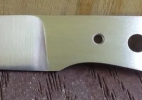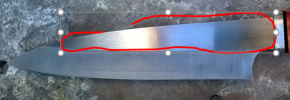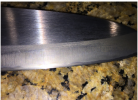- Joined
- Jun 3, 2019
- Messages
- 2,714
Here is a question I have not been able to find an answer to by searching:
I get the progression of finishes through progressively finer grind, then to scotchbright or cork ... BUT what do you do if you are after, say, a scotchbright finish on the bevel, and more of a bright finish (but not necessarily mirror - that is the buffer question again :-( ) on the remaining visible flats of the blade. For example, the image below:

shows a scotchbright finish on the bevel, but a non-satin, brighter, finish on the exposed blade flat just in front of the handle. the same question would apply to any blade flat above the bevel (if you are not doing a full face grind). How do you go about getting that finish?
I get the progression of finishes through progressively finer grind, then to scotchbright or cork ... BUT what do you do if you are after, say, a scotchbright finish on the bevel, and more of a bright finish (but not necessarily mirror - that is the buffer question again :-( ) on the remaining visible flats of the blade. For example, the image below:

shows a scotchbright finish on the bevel, but a non-satin, brighter, finish on the exposed blade flat just in front of the handle. the same question would apply to any blade flat above the bevel (if you are not doing a full face grind). How do you go about getting that finish?



